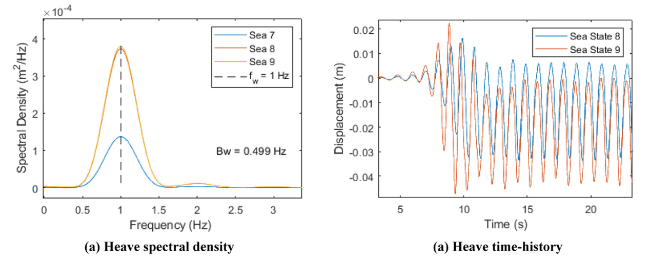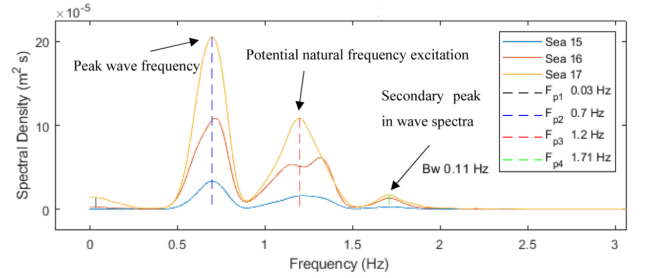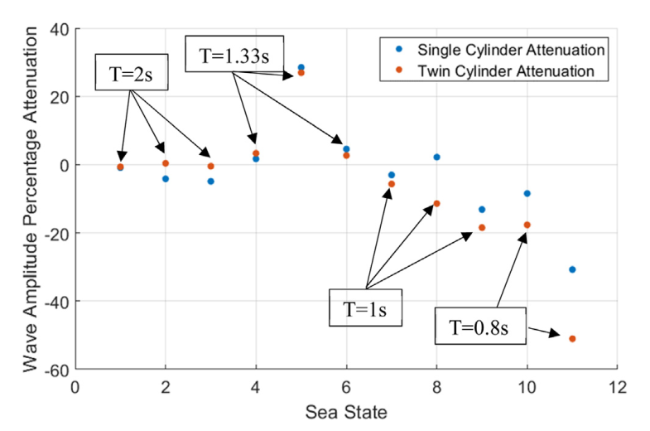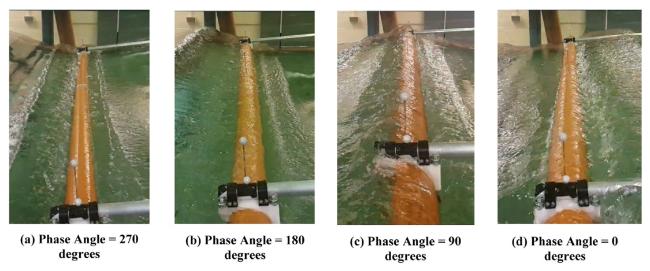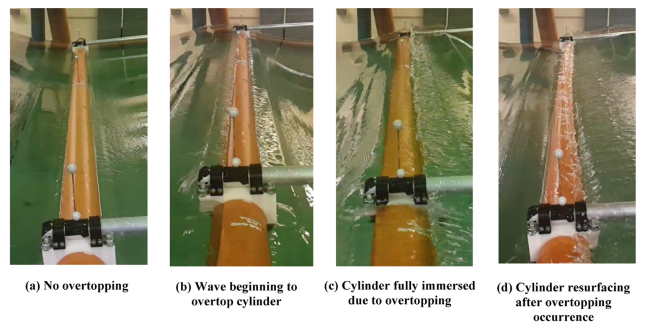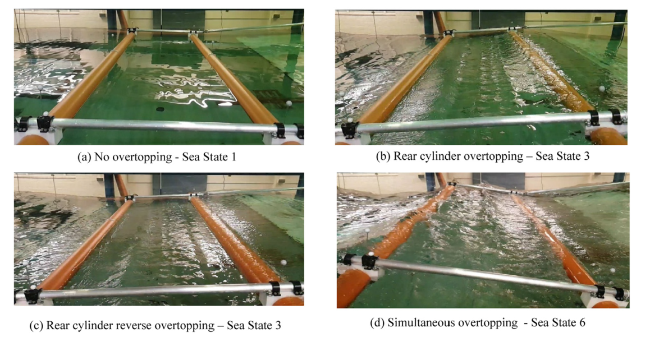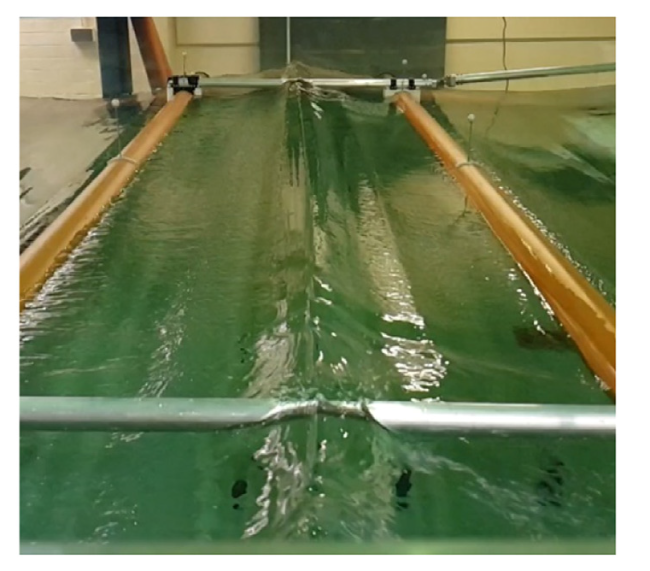1. Introduction
Fig. 1. (A) Floating photovoltaic system in a sheltered water body, (B) Solar duck FPV device for offshore water body. |
2. Model concept
Fig. 2. Gable slender array technology. |
Fig. 3. Gable slender technology [8]. |
Table 1. The scaled FPV model masses. |
| Component | Model scale mass (kg) | |
|---|---|---|
| Single-cylinder | Twin-cylinder | |
| Floater + ballast | 18.79 | 37.58 |
| Aluminium connecting cylinders (3m) | 1.43 | 1.43 |
| Floater connecting cylinders (1.165m) | - | 0.55 |
| Acetal adapters type 1 | 0.97 | 1.94 |
| Acetal adapters type 2 | 0.23 | 0.46 |
| U-bolts and nuts | 1.45 | 2.90 |
| Cylinder adapters type 1 | 0.41 | 0.41 |
| Cylinder adapters type 2 | - | 1.05 |
| Pin-joint mechanisms | 0.42 | 0.84 |
| Total Structural Mass | 23.70 | 47.16 |
Table 2. Experimental properties. |
| Experimental property | Dimension |
|---|---|
| Float diameter | 110.1 mm |
| Float wall thickness | 2 mm |
| Float length | 4510 mm |
| Aluminium connector diameter | 38.1 mm |
| Aluminium connector wall thickness | 1.5 mm |
| Aluminium connector length | 3000 mm |
| Float connecting cylinder length | 1165 mm |
| Displaced mass (p/cylinder) | 22.98 kg |
| Water depth | 0.765 m |
2.1. Discussion of possible error sources
3. Experimental setup
Fig. 4. Top view of twin cylinder model in wave flume. (1) Wave makers, (2) absorption beach, (3) floats, (4), aluminium connector (short), (5) aluminium connector (long), (6) horizontal brace, (7) motion capture cameras (8) hinged plate and load cell mechanism, (9) pin-joint mechanism. |
Fig. 5. Side view of twin cylinder model in wave flume. |
Fig. 6. Load cell and housing illustration. |
Fig. 7. Twin-cylinder experimental model and instrumentation. |
Table 3. Motion capture calibration. |
| Camera | X (m) | Y (m) | Z (m) | Points | Average Residual (mm) |
|---|---|---|---|---|---|
| 01 | -3.111 | -2.419 | 0.713 | 2091 | 0.713 |
| 02 | -2.323 | 2.429 | 0.719 | 1873 | 0.539 |
| 03 | 2.156 | 2.422 | 0.715 | 2090 | 0.427 |
| 04 | 2.503 | -2.417 | 0.716 | 1890 | 0.646 |
Fig. 8. Wave gauge bank setup. |
4. Environmental conditions
4.1. Monochromatic sea states
Table 4. Monochromatic sea state properties. |
| Sea state | Model scale | Full scale | Steepness | ||||||
|---|---|---|---|---|---|---|---|---|---|
| T (s) | H/2 (m) | λ (m) | C (m/s) | T (s) | H/2 (m) | λ (m) | C (m/s) | ||
| 1 | 2.00 | 0.0282 | 4.75 | 2.38 | 4.26 | 0.144 | 21.59 | 5.06 | 0.013 |
| 2 | 2.00 | 0.0534 | 4.76 | 2.39 | 4.26 | 0.290 | 21.64 | 5.07 | 0.027 |
| 3 | 2.00 | 0.0762 | 4.79 | 2.39 | 4.26 | 0.434 | 21.77 | 5.10 | 0.040 |
| 4 | 1.33 | 0.0317 | 2.63 | 1.98 | 2.84 | 0.142 | 11.95 | 4.21 | 0.027 |
| 5 | 1.33 | 0.0502 | 2.65 | 1.98 | 2.84 | 0.296 | 12.05 | 4.24 | 0.049 |
| 6 | 1.33 | 0.0882 | 2.68 | 1.99 | 2.84 | 0.474 | 12.18 | 4.29 | 0.078 |
| 7 | 1.00 | 0.0249 | 1.57 | 1.56 | 2.13 | 0.122 | 7.14 | 3.34 | 0.034 |
| 8 | 1.00 | 0.0507 | 1.60 | 1.57 | 2.13 | 0.250 | 7.27 | 3.40 | 0.069 |
| 9 | 1.00 | 0.0781 | 1.63 | 1.59 | 2.13 | 0.448 | 7.41 | 3.48 | 0.121 |
| 10 | 0.80 | 0.0274 | 1.02 | 1.26 | 1.71 | 0.125 | 4.64 | 2.71 | 0.054 |
| 11 | 0.80 | 0.0568 | 1.07 | 1.29 | 1.71 | 0.263 | 4.86 | 2.86 | 0.108 |
4.2. Stochastic sea states
Table 5. Irregular sea state properties. |
| Sea state | Model scale | Full scale | ||
|---|---|---|---|---|
| Tp (s) | Hs (m) | Tp (s) | Hs (m) | |
| 12 | 2.00 | 0.025 | 4.26 | 0.144 |
| 13 | 2.00 | 0.050 | 4.26 | 0.290 |
| 14 | 2.00 | 0.075 | 4.26 | 0.434 |
| 15 | 1.33 | 0.030 | 2.84 | 0.142 |
| 16 | 1.33 | 0.060 | 2.84 | 0.296 |
| 17 | 1.33 | 0.075 | 2.84 | 0.474 |
| 18 | 1.00 | 0.025 | 2.13 | 0.122 |
| 19 | 1.00 | 0.050 | 2.13 | 0.250 |
| 20 | 1.00 | 0.075 | 2.13 | 0.448 |
Table 6. Spectral calibration properties. |
| Sea | N | Hmo (m) | To1 | εarea | εenergy | ||||
|---|---|---|---|---|---|---|---|---|---|
| Tgen | M | εHmo | Tgen | M | εT01 | ||||
| 12 | 2 | 0.114 | 0.114 | -0.07 | 0.572 | 0.567 | -0.75 | -0.13 | -0.88 |
| 13 | 5 | 0.228 | 0.228 | 0.83 | 0.572 | 0.572 | -0.01 | 1.65 | 1.55 |
| 14 | 2 | 0.341 | 0.341 | 0.12 | 0.572 | 0.572 | -0.21 | 0.25 | 0.04 |
| 15 | 3 | 0.137 | 0.137 | -0.23 | 0.572 | 0.390 | 0.04 | -0.47 | -0.42 |
| 16 | 2 | 0.273 | 0.273 | 0.64 | 0.390 | 0.388 | -0.61 | 1.28 | 0.69 |
| 17 | 5 | 0.337 | 0.337 | -1.93 | 0.390 | 0.397 | -1.57 | -3.89 | -2.26 |
| 18 | 3 | 0.109 | 0.109 | -0.85 | 0.303 | 0.299 | -1.32 | -1.70 | -3.05 |
| 19 | 2 | 0.223 | 0.223 | -0.03 | 0.303 | 0.294 | -2.65 | -0.06 | -2.70 |
| 20 | 2 | 0.332 | 0.332 | 2.21 | 0.303 | 0.290 | -4.63 | 4.37 | -0.05 |
5. Experimental results
5.1. Surge forces
5.1.1. Monochromatic sea states
Fig. 9. Single and twin cylinder (monochromatic sea - normalised minimum surge forces). |
Fig. 10. Single- and twin-cylinder (monochromatic sea - normalised maximum surge forces). |
Table 7. Single cylinder - irregular sea state surge force extrema. |
| Environmental property | RSS maximum surge force | RSS minimum surge force | ||
|---|---|---|---|---|
| Twin-cylinder | Single-cylinder | Twin-cylinder | Single-cylinder | |
| Wave steepness | 21.86e+3 | 32.58e+3 | 3.57e+3 | 22.36e+3 |
| H | 38.67e+3 | 28.71e+3 | 73.78e+3 | 33.63e+3 |
| u | 12.39e+3 | 45.90e+3 | 20.81e+3 | 29.03e+3 |
| w | 13.26e+3 | 42.80e+3 | 7.45e+3 | 26.06e+3 |
| $ \dot{u} $ | 21.90e+3 | 61.26e+3 | 3.71e+3 | 46.50e+3 |
| $ \dot{ w } $ | 30.82e+3 | 64.53e+3 | 9.90e+3 | 53.26e+3 |
Fig. 11. Twin cylinder load cell power spectral density (Bw = Bandwidth of the Parzen window). |
5.1.2. Irregular sea states
Table 8. Single cylinder - irregular sea state surge force extrema. |
| Sea state | SC - Surge force maxima (N) | SC - Surge force minima (N) | TC - Surge force maxima (N) | TC - Surge force minima (N) |
|---|---|---|---|---|
| 12 | 19.99 | -18.64 | 34.81 | -29.36 |
| 13 | 40.82 | -42.42 | 54.72 | -60.93 |
| 14 | 91.32 | -63.15 | 90.01 | -111.68 |
| 15 | 41.01 | -42.87 | 56.44 | -51.22 |
| 16 | 87.87 | -88.53 | 122.93 | -116.04 |
| 17 | 129.77 | -137.37 | 162.19 | -176.80 |
| 18 | 37.97 | -45.09 | 79.30 | -76.20 |
| 19 | 87.93 | -99.81 | 143.14 | -166.23 |
| 20 | 159.54 | -173.76 | 241.58 | -232.40 |
Fig. 12. Single cylinder model - load cell time-history - sea state 17. |
Fig. 13. Twin cylinder model - load cell time-history - sea state 17. |
Fig. 14. Single-cylinder model - load cell spectra - sea states 18-20. |
Fig. 15. Twin cylinder model - load cell spectra - sea states 12-14. |
5.2. Motion responses
5.2.1. Monochromatic sea states
Fig. 16. Mean heave displacement monochromatic sea states. |
Fig. 17. Twin cylinder model heave motion results in load case 8 and 9. |
5.2.2. Irregular sea states
Fig. 18. Heave motions twin-cylinder model during sea state 12. |
Fig. 19. Pitch motions twin-cylinder model during sea state 12. |
Fig. 20. Twin cylinder model heave spectral densities (sea states 15-17). |
5.3. Wave attenuation
Fig. 21. Wave attenuation as a percentage change as of the original undisturbed wave amplitude. |
6. Experimental observations
6.1. Single cylinder overtopping
Fig. 22. Single cylinder overtopping observations. |
Fig. 23. Single cylinder sea state 6 - wave cycle illustration with approximate phase angles. |
Fig. 24. Single cylinder sea state 6 - overtopping occurrence. |
6.2. Twin-cylinder overtopping
Fig. 25. Twin cylinder overtopping observation examples. |
6.3. Radiative damping and reflections
Fig. 26. Radiative damping occurrences in various sea states. |
Fig. 27. Constructive interference phenomenon between twin cylinder model during sea state 6. |
6.4. Constructive Interference
Fig. 28. Constructive interference phenomenon occurring in sea state 5. |


















